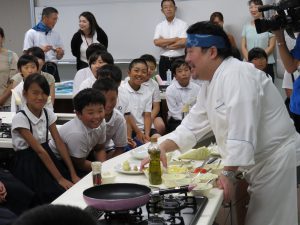上板町立高志小学校が地域と協働で進める食品ロス削減の取組/ Elementary School to reduce food loss in collaboration with local communities/上板町立高志小学校与地域共同协作推进的削减食品浪费活动
上板町立高志小学校では、2017年度からESD、SDGsの本格的な実践を開始し、衣と食を中心として、地域の自然環境と動植物の命をつなぐことをテーマに、教育活動を展開している。具体的には、生産者、JA、NPO、企業、行政等と連携し、規格外の農産物を学校給食で活用することを通じて、食品ロス削減の意味や、地場産業の重要性について伝えている。2019年度には、文部科学省が実施する、社会的課題に対応した学校給食活用事業における上板町のモデル校となり、地産地消を通した食品ロスの削減の実践研究を開始した。
はじめに取り組んだのは、収穫後損失を減らすために、規格外野菜や果物等、廃棄される作物を畑から収穫(二次収穫)し、学校給食に活用することだった。生産者の協力を得て、3、4、6年生が春から夏にかけて、ニンジン約300㎏、ブロッコリー約80㎏、桃約100個を収穫し、それらを六次化支援施設で学校給食に使用できる状態へ加工してもらい、冷凍保存した。これらは、町内の幼稚園、小学校、中学校の約1,100名分の給食に使用された。給食センターでも食品残さを減らすために、ニンジンの皮をむかない、キャベツの芯を利用する等の工夫を行い、昨年は平均26.2㎏あった食品残さを、今年は15.9㎏まで減らすことができた。また、6年生が町内の牧場が規格外の鳴門金時をエサに利用していることを学習したことから、この野菜残さを牧場に提供することを提案し、5月からは最終残さがほぼゼロ(豚のエサに適さない玉ねぎ・ねぎを除く)になっている。5月から9月に削減できた野菜残さは、約1tにもなった。

さらに、子どものニーズをとらえ、旬の食材を使い、食品ロスが出ない学校給食メニューづくりと、そのメニューを学校給食に提供する実践も行った。9月から4、5、6年生の児童と学級担任、上板町福祉保健課、地産地消を推進する団体、学校給食センター栄養士が話し合い、町内の幼稚園、小学校、中学校生徒約1,100名全員がおいしく食べ、食べ残しがゼロになる学校給食メニューを考えた。栄養士が提案した7種類のメニューから1種類を選び、味のイメージ、色のイメージを考え、タブレットアプリを使って集めた情報を参考に、アレンジを加えた。話し合いで決定したメニューは、さつまいものポタージュ「栄養たっぷりさつまージュ」。このメニューが、10月31日に給食で提供され、「あまくておいしい」「パンによく合う」と完食した。

次年度以降も取組が継続できるように、高志小学校と上板町学校給食センターが中心となって関係機関と協議を行い、食品ロス削減の取組が組織的にできる体制づくりを目指した。そして、役場やJA、六次化支援施設、地産地消を推進するレストラン、生産者等との協働体制を確立した。現在は、上板町産業課とJA板野郡の提案・協力で、作物別生産者リストを作成していただき、二次収穫に協力いただける生産者を増やし、収穫後損失の活用に向けた協力体制ができつつある。
高志小学校では、食品ロスを削減することの重要性を、体験を通して五感で学ぶことで、SDGsの目指す新しい価値を創る子どもの育成につなげようとしている。これらの取組が認められ、2019年2月には、第9回ESD大賞の小学校賞に四国で初めて選ばれた。地域にある資源を活かし、地域の方々の協力を得ながら、持続可能なまちづくりを考える子どもたちが、今、育ちつつある。
■Elementary School to reduce food loss in collaboration with local communities
Kamiita Municipal Takashi Elementary School has begun a full-scale implementation of ESD and SDGs educational activities focusing on clothing and food with the theme of connecting the local natural environment to the life of animals and plants. With the cooperation producers, such as JA, NPOs, companies, governments, etc., they demonstrate the significance of reducing food loss and the importance of local industry through the use of nonstandard agricultural products for school lunches. In 2019, Kamiita Municipal Takashi Elementary became the model school in Kamiita-cho conducted by the Ministry of Education, Culture, Sports, Science, and Technology because of its lunch utilization project that addresses social issues and practical studies on reducing food loss through local production and consumption.
The first task was to harvest discarded crops. They harvested fruits and vegetables that can not be sold in stores because of their shape or size and used them for school lunches to reduce post-harvest losses. With the cooperation of producers, third-, fourth-, and sixth-year students harvest about 300 kg of carrots, about 80 kg of broccoli, and about 100 peaches during spring and summer. They sent them to the Sixth Support Facility were they processed them for school meals and they could be stored frozen. These were used for about 1,100 children’s lunches in kindergarten, elementary school, and junior high school. To reduce food residue, the school lunch center also took measures such as peeling carrots and using cabbage cores and was able to reduce food residue from 26.2㎏ last year to 15.9㎏ this year on average. Also, since the sixth graders learned that the ranch in the town uses discarded Naruto Kintoki (a kind of sweet potato) as food, they proposed to provide the vegetable residue to the ranch. Since May, the final residue was close to none (excluding onions and green onions that are not suitable for feeding pigs). From May to September, about 1t of vegetable residue was reduced.
In addition, the school prepared a school lunch menu that captures children’s needs using seasonal ingredients and does not cause food loss. From September, students in grades 4, 5, 6 and their teachers, the Kamiitacho Health and Welfare Division, groups promoting local production for local consumption, and school lunch center dietitians discussed delicious and food loss less school lunch menu for about 1,100 kindergartens, elementary schools and junior high school students in the town. One of the seven menus proposed by the dietitian was selected, the taste and color image was considered, and an arrangement was added based on the information collected using the tablet app. The menu we decided on after the discussion was a potage of sweet potatoes called “nutritious sweets”. This menu was offered for lunch on October 31, and was commented as “Amazing and delicious” and “Good with bread”.
The Takashi Elementary School and Kamiitacho School Lunch Center held discussions with related organizations so that efforts could be continued to the next year, to create a system in which initiatives to reduce food loss. Also, we have established a cooperative system with government offices, JA, facilities for the promotion of sixth-order facilities, restaurants that promote local production for local consumption, and producers. Currently, with the proposal and cooperation of the Kamiitamachi Industry Division and JA Itano-gun, a list is being created for producers for each crop created. Thanks to it, the number of producers who can cooperate in secondary harvesting, and cooperate to utilize post-harvest losses is increasing.
At Takashi Elementary School, trying to learn the importance of reducing food loss with the five senses experience will lead to the development of children who will create the new value that the SDGs aim for. These efforts are being recognized, and in February 2019, they were selected the 9th ESD Grand Prize for Elementary School for the first time in Shikoku. Children who are thinking about sustainable town development, utilizing local resources are now growing up with the support of local people.
■上板町立高志小学校与地域共同协作推进的削减食品浪费活动
上板町立高志小学校从2017年度正式开始了ESD、SDGs的实践活动,以衣与食为中心,以保护地域自然环境与动植物生命为主题,开展了教育活动。具体来说,就是通过生产者、JA、NPO、企业、行政等共同协作,将不符合标准规格的农产物作为学校午餐的原材料利用,传达削减食品浪费和本地产业的重要性。 2019年度,成为文部科学省实施的灵活利用学校午餐解答社会课题的上板町模范学校,开始了通过地产地消削减食物浪费的实践研究。
首先开始的活动是,为了减少收获后的损失,将田地里不符合标准规格的蔬菜水果等、作废的农作物收获(二次收获),利用到学校午餐中。在生产者的帮助下, 3、4、6年级的学生从春天到夏天,共收获了约300㎏胡萝卜、约80㎏西兰花、约100个桃子,然后在六次化支持施设加工成为能够用于学校午餐的状态,冷冻保存。这些食品为町内的幼儿园、小学校、中学校的约1,100名人提供了午餐。为了削减食物残余,午餐中心也开始了胡萝卜不去皮、使用高丽菜心等的行动,去年有26.2㎏的食物残余,今年减少了到15.9㎏。不仅如此,6年级学生还在町内的牧场,学习将不符合标准规格的鸣门金时地瓜作为饲料利用,提出将蔬菜残余提供给牧场的方案,5月开始最终的残余几乎接近于零(除去不适合作为猪饲料的洋葱・葱)。5月到9月削减的蔬菜残余,大约有1t之多。
不仅如此,为满足孩子们的需求,使用当季食材,减少食品浪费,他们还制作了新的学校午餐菜单,被使用学校午餐。 9月开始,4、5、6年级学生和年级老师、上板町福祉保健课、地产地消推进团体、以及学校午餐中心营养师共同讨论,探讨思考了为町内的幼儿园、 小学、中学约1,100名学生全员提供美味且不浪费的学校午餐菜单。从营养师提出的7种菜单中选择一种,考虑味道和颜色,参考使用平板App收集的信息,予以整合。讨论最终决定,将さつまいものポタージュ(地瓜奶油汤)「栄養たっぷりさつまージュ(营养满满地瓜汤)」作为菜单。这一菜单在10月31日提供给了学生们,受到了「真甜真好吃」「很适合配面包」的好评,被一扫而光。
为了在下一年度继续活动,以高志小学和上板町学校午餐中心为中心,有关机构达成了合作协议,目标是形成有组织的减少食品浪费的体制。而且,确立了地方政府和JA、六次化支持施设、推进地产地消的餐馆、生产者等共同协作的体制。现在,通过上板町产业课与JA板野郡的提案・协作,制作各种农作物分门别类的生产者名单,增加二次收获帮助的生产者,利用収获后的损失等的协作体制。
在高志小学,通过亲身体验,全面的学习了削减食品浪费的重要性,以SDGs为目标,致力于培养能够创造新价值的孩子。这样的举措受到了认可。2019年2月,第9回ESD大奖的小学奖,在四国第一次被颁发了奖项。地域的资源灵活利用,争取地域各方面的帮助下培养思考建设可持续发展城市的孩子们,正在成长中。



